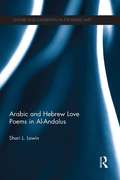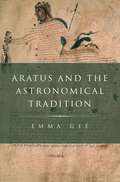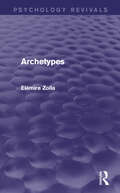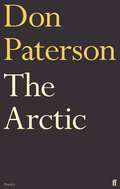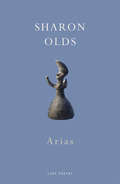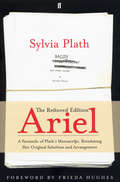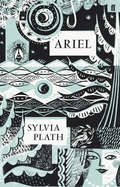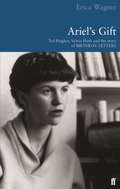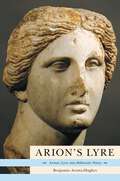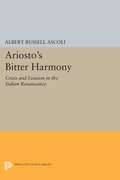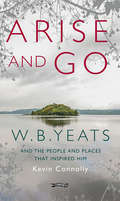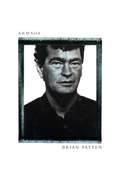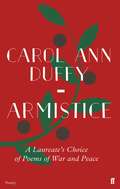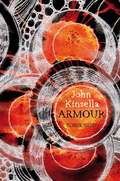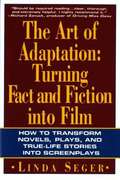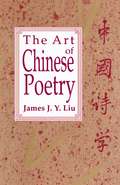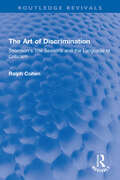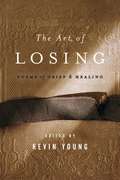- Table View
- List View
Arabic and Hebrew Love Poems in Al-Andalus (Culture and Civilization in the Middle East)
by Shari LowinArabic and Hebrew Love Poems in al-Andalus investigates a largely overlooked subset of Muslim and Jewish love poetry in medieval Spain: hetero- and homo-erotic love poems written by Muslim and Jewish religious scholars, in which the lover and his sensual experience of the beloved are compared to scriptural characters and storylines. This book examines the ways in which the scriptural referents fit in with, or differ from, the traditional Andalusian poetic conventions. The study then proceeds to compare the scriptural stories and characters as presented in the poems with their scriptural and exegetical sources. This new intertextual analysis reveals that the Jewish and Muslim scholar-poets utilized their sacred literature in their poems of desire as more than poetic ornamentation; in employing Qur’ānic heroes in their secular verses, the Muslim poets presented a justification of profane love and sanctification of erotic human passions. In the Hebrew lust poems, which utilize biblical heroes, we can detect subtle, subversive, and surprisingly placed interpretations of biblical accounts. Moving beyond the concern with literary history to challenge the traditional boundaries between secular and religious poetry, this book provides a new, multidisciplinary, approach to existing materials and will be of interest to students, scholars and researchers of Islamic and Jewish Studies as well as to those with an interest in Hebrew and Arabic poetry of Islamic Spain.
Arabic and Hebrew Love Poems in Al-Andalus (Culture and Civilization in the Middle East)
by Shari LowinArabic and Hebrew Love Poems in al-Andalus investigates a largely overlooked subset of Muslim and Jewish love poetry in medieval Spain: hetero- and homo-erotic love poems written by Muslim and Jewish religious scholars, in which the lover and his sensual experience of the beloved are compared to scriptural characters and storylines. This book examines the ways in which the scriptural referents fit in with, or differ from, the traditional Andalusian poetic conventions. The study then proceeds to compare the scriptural stories and characters as presented in the poems with their scriptural and exegetical sources. This new intertextual analysis reveals that the Jewish and Muslim scholar-poets utilized their sacred literature in their poems of desire as more than poetic ornamentation; in employing Qur’ānic heroes in their secular verses, the Muslim poets presented a justification of profane love and sanctification of erotic human passions. In the Hebrew lust poems, which utilize biblical heroes, we can detect subtle, subversive, and surprisingly placed interpretations of biblical accounts. Moving beyond the concern with literary history to challenge the traditional boundaries between secular and religious poetry, this book provides a new, multidisciplinary, approach to existing materials and will be of interest to students, scholars and researchers of Islamic and Jewish Studies as well as to those with an interest in Hebrew and Arabic poetry of Islamic Spain.
Archangel
by Henry ShukmanIt has been over a decade since Henry Shukman published his award-winning first collection, In Doctor No’s Garden. Now, in his greatly anticipated second collection, he explores a little-known piece of Jewish history, in a sequence of poems that forms the centre-piece of this book. In 1917 several thousand Jewish tailors were deported from London and shipped back to Archangel and the Russian Empire they had recently fled, ostensibly to fight on the Eastern Front. They arrived just as the Revolution was unfolding and the old regime was collapsing into chaos. Among them were Shukman’s grandfather and great-uncle, and these poems chronicle their four-year struggle to return to their wives and children in London.With poems on loss and mortality, on love in difficult circumstances, and on the familiar themes of childhood and family relationships, Archangel tells the stories of many journeys – from youth to maturity, from loss back into love – and the migrations of Shukman’s Jewish grandparents are echoed in his own move with his wife and family from England to New Mexico. Whatever the theme, though, these are all love poems: poems lucid with intensity, bright with the longing for love – both its fleeting rapture and its slow contentment – and Archangel is a book of great reach, power and beauty.
Archetypes (Psychology Revivals)
by Elémire ZollaMan is dominated by his archetypes; they mould not only his history but his dreams. But how are we to define and evaluate them? Is it perhaps possible for us to relate more creatively to them? Originally published in 1981, these are some of the questions raised by this title. To answer them the author gathered together a vast amount of material drawn from Eastern and Western traditions, from science, literature, art and poetry. The answers he puts forward are often highly original and will surely challenge many of our most cherished patterns of thought. There emerges from this book what can only be described as a global metaphysical system, yet the author’s language is not that of an ordinary metaphysical treatise, and what he writes offered new challenge and hope to those suffering from the despair and cynicism engendered by a great deal in modern society at the time. Zolla does not, however, advocate a return to earlier historical patterns, nor is he proposing a new Utopia, but rather offers us a brilliant series of lessons in the art of centring. In the words of Bernard Wall, writing in the Times Literary Supplement, Zolla’s ‘deep, polymathic probing of the terms of human existence makes it sensible to compare him with Simone Weil, while some of his conclusions about ultimate mysteries – expressed in signs, symbols and sacraments, the sense of which we have lost – will make us think of the later T. S. Eliot’.
Archetypes (Psychology Revivals)
by Elémire ZollaMan is dominated by his archetypes; they mould not only his history but his dreams. But how are we to define and evaluate them? Is it perhaps possible for us to relate more creatively to them? Originally published in 1981, these are some of the questions raised by this title. To answer them the author gathered together a vast amount of material drawn from Eastern and Western traditions, from science, literature, art and poetry. The answers he puts forward are often highly original and will surely challenge many of our most cherished patterns of thought. There emerges from this book what can only be described as a global metaphysical system, yet the author’s language is not that of an ordinary metaphysical treatise, and what he writes offered new challenge and hope to those suffering from the despair and cynicism engendered by a great deal in modern society at the time. Zolla does not, however, advocate a return to earlier historical patterns, nor is he proposing a new Utopia, but rather offers us a brilliant series of lessons in the art of centring. In the words of Bernard Wall, writing in the Times Literary Supplement, Zolla’s ‘deep, polymathic probing of the terms of human existence makes it sensible to compare him with Simone Weil, while some of his conclusions about ultimate mysteries – expressed in signs, symbols and sacraments, the sense of which we have lost – will make us think of the later T. S. Eliot’.
The Arctic
by Don PatersonIn this new collection from Don Paterson, 'The Arctic' is the bar frequented in the backstreet of a post-apocalyptic world. Under its echoey aegis are gathered poems about men and women, polemical responses to a pandemic, microdot poems, odes to dogs, to movies and the male anatomy, and, in the chill undertow, a series of poems that mourn the poet's musician father. Other poets are drawn in from the cold, including the Chilean poet, Gabriela Mistral, whose verses are magically transformed to Paterson's native Scots; there are versions, too, of Cavafy, Montale and Unamuno. And in the fourth part Paterson's ongoing long poem 'The Alexandrian Library', travelling from a weather station at the top of Ben Nevis to the cellar back at The Arctic Bar, we are witness to the imminence of man-made extinction. By turn, urgent, railing, tender, these are poems for our times, by one of our most celebrated and formally adventurous poets.
Arias
by Sharon Olds*SHORTLISTED FOR THE 2019 T. S. ELIOT PRIZE*Following her recent Odes, the Pulitzer Prize-winning poet gives us a new collection of poems that sing of a woman’s intimate life and political conscience. The atom bomb, Breaking Bad, the cervix, Trayvon Martin, her mother’s return from the dead: the peerless Sharon Olds once again takes up subject matter that is both difficult and ordinary, elusive and everywhere. Each aria is shaped by its unique melody and moral logic, as Olds stands centre stage to account for her own late romance and chance wisdom, and faces the tragic life of our nation and our planet. ‘I cannot say I did not ask / to be born,’ begins one aria, which considers how, with what actions, with what thirst, we each ask for a turn, and receive our portion on earth. Olds delivers these pieces with all the passion, anguish, and solo force that make a great performance, in the process enlarging the soul of her readers.
Ariel: A Facsimile Of Plath's Manuscript, Reinstating Her Original Selection And Arrangement (P. S. Ser.)
by Sylvia PlathUpon the publication of her posthumous volume of poetry Ariel in 1965, Sylvia Plath became a household name. Readers may be surprised to learn that the draft of Ariel left behind by Plath when she died in 1963 is different from the volume of poetry eventually published to worldwide acclaim.This facsimile edition restores, for the first time, the selection and arrangement of the poems Sylvia Plath left at the point of her death. In addition to the facsimile pages of Sylvia Plath's manuscript, this edition also includes in facsimile the complete working drafts of the title poem 'Ariel' in order to offer a sense of Plath's creative process, as well as notes the author made for the BBC about some of the manuscript's poems, including 'Daddy' and 'Lady Lazarus'In her insightful foreword to this volume, Frieda Hughes, Sylvia Plath's daughter, explains the reasons for the differences between the previously published edition of Ariel as edited by her father, Ted Hughes, and her mother's original version published here. With this publication, Sylvia Plath's legacy and vision will be reevaluated in the light of her original working draft.
Ariel: A Facsimile Of Plath's Manuscript, Reinstating Her Original Selection And Arrangement (Poesia Hiperion Ser.)
by Sylvia PlathThe poems in Sylvia Plath's Ariel, including many of her best-known such as 'Lady Lazarus', 'Daddy', 'Edge' and 'Paralytic', were all written between the publication in 1960 of Plath's first book, The Colossus, and her death in 1963. 'If the poems are despairing, vengeful and destructive, they are at the same time tender, open to things, and also unusually clever, sardonic, hardminded . . . They are works of great artistic purity and, despite all the nihilism, great generosity . . . the book is a major literary event.' A. Alvarez in the ObserverThis beautifully designed edition forms part of a series with five other cherished poets, including Wendy Cope, Don Paterson, Philip Larkin, Simon Armitage and Alice Oswald.
Ariel's Gift: Ted Hughes, Sylvia Plath And The Story Of Birthday Letters
by Erica WagnerErica Wagner provides a comprehensive guide to the poems that must constitute one of the most extraordinary and powerful volumes published in the last century. When Ted Hughes's Birthday Letters was published in 1998, it was greeted with astonishment and acclaim. Few suspected that Ted Hughes had been at work, for a quarter of a century, on a cycle of poems addressed almost entirely to his first wife, the American poet Sylvia Plath. In Ariel's Gift, Erica Wagner offers a commentary on the poems, pointing the reader towards the events that shaped them, and, crucially, showing how they draw upon Plath's own work.
Arion's Lyre: Archaic Lyric into Hellenistic Poetry (PDF)
by Benjamin Acosta-HughesArion's Lyre examines how Hellenistic poetic culture adapted, reinterpreted, and transformed Archaic Greek lyric through a complex process of textual, cultural, and creative reception. Looking at the ways in which the poetry of Sappho, Alcaeus, Ibycus, Anacreon, and Simonides was preserved, edited, and read by Hellenistic scholars and poets, the book shows that Archaic poets often look very different in the new social, cultural, and political setting of Hellenistic Alexandria. For example, the Alexandrian Sappho evolves from the singer of Archaic Lesbos but has distinct associations and contexts, from Ptolemaic politics and Macedonian queens to the new phenomenon of the poetry book and an Alexandrian scholarship intent on preservation and codification. A study of Hellenistic poetic culture and an interpretation of some of the Archaic poets it so lovingly preserved, Arion's Lyre is also an examination of how one poetic culture reads another--and how modern readings of ancient poetry are filtered and shaped by earlier readings.
Arion's Lyre: Archaic Lyric into Hellenistic Poetry
by Benjamin Acosta-HughesArion's Lyre examines how Hellenistic poetic culture adapted, reinterpreted, and transformed Archaic Greek lyric through a complex process of textual, cultural, and creative reception. Looking at the ways in which the poetry of Sappho, Alcaeus, Ibycus, Anacreon, and Simonides was preserved, edited, and read by Hellenistic scholars and poets, the book shows that Archaic poets often look very different in the new social, cultural, and political setting of Hellenistic Alexandria. For example, the Alexandrian Sappho evolves from the singer of Archaic Lesbos but has distinct associations and contexts, from Ptolemaic politics and Macedonian queens to the new phenomenon of the poetry book and an Alexandrian scholarship intent on preservation and codification. A study of Hellenistic poetic culture and an interpretation of some of the Archaic poets it so lovingly preserved, Arion's Lyre is also an examination of how one poetic culture reads another--and how modern readings of ancient poetry are filtered and shaped by earlier readings.
Ariosto's Bitter Harmony: Crisis and Evasion in the Italian Renaissance (PDF)
by Albert Russell AscoliFocusing on the fundamental Ariostan pairing of education and madness, with all its implications for poetry, Professor Ascoli generates a global reading of the greatest literary work of the Italian Renaissance.Originally published in 1987.The Princeton Legacy Library uses the latest print-on-demand technology to again make available previously out-of-print books from the distinguished backlist of Princeton University Press. These editions preserve the original texts of these important books while presenting them in durable paperback and hardcover editions. The goal of the Princeton Legacy Library is to vastly increase access to the rich scholarly heritage found in the thousands of books published by Princeton University Press since its founding in 1905.
Arise And Go: W.B. Yeats and the people and places that inspired him
by Kevin ConnollyThe idea of place runs like a river through the life and works of the poet and playwright W.B. Yeats. This book focuses on his time in Dublin, London, Sligo and elsewhere in the west of Ireland, embracing the homes, landscapes and people that impacted his life and stimulated his vast body of work. Meet the poet’s father, the struggling artist John Butler Yeats; his mother Susan, the well-to-do Sligo girl who had no choice but to follow her husband’s path; his five siblings: Lily and Lolly, guiding lights in the Irish Arts and Crafts movement; Jack, the renowned painter; and Bobbie and Jane Grace, who died in infancy. Meet William Morris, John O’Leary, Katharine Tynan, George Moore, Oscar Wilde, Lady Gregory, Douglas Hyde, George Hyde-Lees, and, of course, Maud Gonne, as well as countless others who helped weave the cloth of Yeats’s poetic gift.
Armada
by Brian PattenThrough the fads and fashions of the last thirty years Brian Patten has remained true to his own personal vision of poetry. Whether composing lamentations to the terrible beauty of human love, or writing his outstanding popular verse for children, he has continued to articulate and illuminate the joys and sorrows of the everyday world.
Armistice: A Laureate's Choice of Poems of War and Peace (Faber Poetry Ser.)
by Carol Ann DuffyThe Armistice of 1918 brought ceasefire to the war on the Western Front, but 'the Great War' would not as hoped be 'the war to end all wars'. In this affecting selection, the Poet Laureate, Carol Ann Duffy, guides us deep into the act and root of 'armistice': its stoppage or 'stand' of arms, its search for truce and ceasefire. In 100 poems, our most cherished poets of the Great War speak alongside those from other conflicts and cultures, so that we hear some of the lesser-heard voices of war, including wives, families, those left behind. These poems of war and peace memorialise the horror and the tragedy of conflict. At the same time, in armistice, they become a record of renewal and a testimony to hope.
Armour
by John KinsellaWith Armour, the great Australian poet John Kinsella has written his most spiritual work to date – and his most politically engaged. The world in which these poems unfold is strangely poised between the material and the immaterial, and everything which enters it – kestrel and fox, moth and almond – does so illuminated by its own vivid presence: the impression is less a poet honouring his subjects than uncannily inhabiting them. Elsewhere we find a poetry of lyric protest, as Kinsella scrutinizes the equivocal place of the human within this natural landscape, both as tenant and self-appointed steward. Armour is a beautifully various work, one of sharp ecological and social critique – but also one of meticulous invocation and quiet astonishment, whose atmosphere will haunt the reader long after they close the book. Praise for John Kinsella: ‘Kinsella’s poems are a very rare feat: they are narratives of feeling. Vivid sight – of landscapes, of animals, of human forms in distant light – becomes insight. There is, often, the shock of the new. But somehow awaited, even familiar. Which is the homecoming of a true poet’ George Steiner
The Art and Thought of the "Beowulf" Poet
by Leonard NeidorfIn The Art and Thought of the Beowulf Poet, Leonard Neidorf explores the relationship between Beowulf and the legendary tradition that existed prior to its composition. The Beowulf poet inherited an amoral heroic tradition, which focused principally on heroes compelled by circumstances to commit horrendous deeds: fathers kill sons, brothers kill brothers, and wives kill husbands. Medieval Germanic poets relished the depiction of a hero's unyielding response to a cruel fate, but the Beowulf poet refused to construct an epic around this traditional plot. Focusing instead on a courteous and pious protagonist's fight against monsters, the poet creates a work that is deeply untraditional in both its plot and its values. In Beowulf, the kin-slayers and oath-breakers of antecedent tradition are confined to the background, while the poet fills the foreground with unconventional characters, who abstain from transgression, display courtly etiquette, and express monotheistic convictions. Comparing Beowulf with its medieval German and Scandinavian analogues, The Art and Thought of the Beowulf Poet argues that the poem's uniqueness reflects one poet's coherent plan for the moral renovation of an amoral heroic tradition. In Beowulf, Neidorf discerns the presence of a singular mind at work in the combination and modification of heroic, folkloric, hagiographical, and historical materials. Rather than perceive Beowulf as an impersonally generated object, Neidorf argues that it should be read as the considered result of one poet's ambition to produce a morally edifying, theologically palatable, and historically plausible epic out of material that could not independently constitute such a poem.
The Art of Adaptation: Turning Fact and Fiction into Film (PDF)
by Linda SegerAdaptations have long been a mainstay of Hollywood and the television networks. Indeed, most Academy Award- and Emmy Award-winning films have been adaptations of novels, plays, or true-life stories. Linda Seger, author of two acclaimed books on scriptwriting, now offers a comprehensive handbook for screenwriters, producers, and directors who want to successfully transform fictional or factual material into film. Seger tells how to analyze source material to understand why some of it resists adaptation. She then gives practical methods for translating story, characters, themes, and style into film. A final section details essential information on how to adapt material and how to protect oneself legally
The Art of Chinese Poetry
by James J. LiuThis concise introduction to Chinese poetry serves as a primer for English-speakers eager to expand their understanding and enjoyment of Chinese culture. James J. Y. Liu first examines the Chinese language as a medium of poetic expression and, contrary to the usual focus on the visual qualities of Chinese script, emphasizes the auditory effects of Chinese verse. He provides a succinct survey of Chinese poetry theory and concludes with his own view of poetry, based upon traditional Chinese concepts. "[This] books should be read by all those interested in Chinese poetry."—Achilles Fang, Poetry "[This is] a significant contribution to the understanding and appreciation of Chinese poetry, lucidly presented in a way that will attract a wide audience, and offering an original synthesis of Chinese and Western views that will stimulate and inspire students of poetry everywhere."—Hans H. Frankel, Harvard Journal of Asiatic Studies "This is a book which can be recommended without reservation to anyone who wants to explore the world of Chinese poetry in translation."—James R. Hightower, Journal of Asian Studies
The Art of Discrimination: Thomson's The Seasons and the Language of Criticism (Routledge Revivals)
by Ralph CohenFirst published in 1964, The Art of Discrimination is a study in the relation between critical theory and practice, taking as its test-case James Thomson’s The Seasons, the poem which was, according to Johnson, of "a new kind". Professor Cohen explores the different applications of criticism from 1750 to 1950, analysing specific interpretations of the poem that altered, contradicted or supported poetic theory. In doing so, he introduces new techniques to supplement traditional critical commentary: illustrations are treated as interpretations and critical language is related to non-literary as well as literary information. In treating the history of critical interpretation, the reprinting of editions and past interpretations are considered along with contemporary statements as necessary to define a literary period. The book offers alternatives to theories of organicism and to those of the arbitrariness of literary history by defining the kinds of continuities that exist in criticism. As analysis of criticism, it studies how men think about literature, the extent to which such thinking resists systematization and those elements in it which can be controlled and organized and transmitted. The book will appeal to students of literature and critical theory.
The Art of Discrimination: Thomson's The Seasons and the Language of Criticism (Routledge Revivals)
by Ralph CohenFirst published in 1964, The Art of Discrimination is a study in the relation between critical theory and practice, taking as its test-case James Thomson’s The Seasons, the poem which was, according to Johnson, of "a new kind". Professor Cohen explores the different applications of criticism from 1750 to 1950, analysing specific interpretations of the poem that altered, contradicted or supported poetic theory. In doing so, he introduces new techniques to supplement traditional critical commentary: illustrations are treated as interpretations and critical language is related to non-literary as well as literary information. In treating the history of critical interpretation, the reprinting of editions and past interpretations are considered along with contemporary statements as necessary to define a literary period. The book offers alternatives to theories of organicism and to those of the arbitrariness of literary history by defining the kinds of continuities that exist in criticism. As analysis of criticism, it studies how men think about literature, the extent to which such thinking resists systematization and those elements in it which can be controlled and organized and transmitted. The book will appeal to students of literature and critical theory.
The Art Of Life
by Paul DurcanIn The Art of Life Paul Durcan takes us around County Mayo in his "filthy, two-door, bottle-green Opel Astra", stopping off at Westport and Achill Island, where he declares himself to be "globally sad", but "locally glad". Next he travels east to Dublin to hold in his arms his newborn granddaughter and thence to Tuscany, Poland and Japan. Along the way he reflects upon parental pride, the aches and pains of old age, the trim bottoms of snooker players, the wisdom of ex-wives and dogs on Sandymount Strand, while introducing us to a host of colourful characters, including a bishop, a roofer, a milkman, a priest and an unmarried mother. Is there an art of living or is life a work of art? This magnificent collection - originally published on Paul Durcan's sixtieth birthday - reveals one of Ireland's most successful and popular poets at the height of his powers and continuing to challenge, amuse and delight.
The Art of Losing: Poems of Grief and Healing
by Kevin Young“Kevin Young has thoughtfully gathered many of these sorrowful perambulations and grievous plummets.” -Billy CollinsThe Art of Losing is the first anthology of its kind, delivering poetry with a purpose. Editor Kevin Young has introduced and selected 150 devastatingly beautiful poems that embrace the pain and heartbreak of mourning. Divided into five sections (Reckoning, Remembrance, Rituals, Recovery, and Redemption), with poems by some of our most beloved poets as well as the best of the current generation of poets, The Art of Losing is the ideal gift for a loved one in a time of need and for use by therapists, ministers, rabbis, and palliative care workers who tend to those who are experiencing loss. Among the poets included: Elizabeth Alexander, W. H. Auden, Amy Clampitt, Billy Collins, Emily Dickinson, Louise Gluck, Ted Hughes, Galway Kinnell, Kenneth Koch, Philip Larkin, Li-Young Lee, Philip Levine, Marianne Moore, Sharon Olds, Mary Oliver, Robert Pinsky, Adrienne Rich, Theodore Roethke, Anne Sexton, Wallace Stevens, Dylan Thomas, Derek Walcott, and James Wright.
